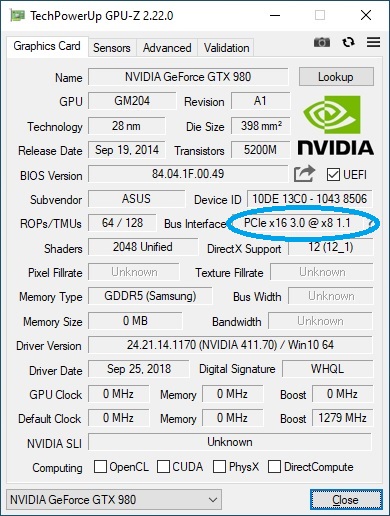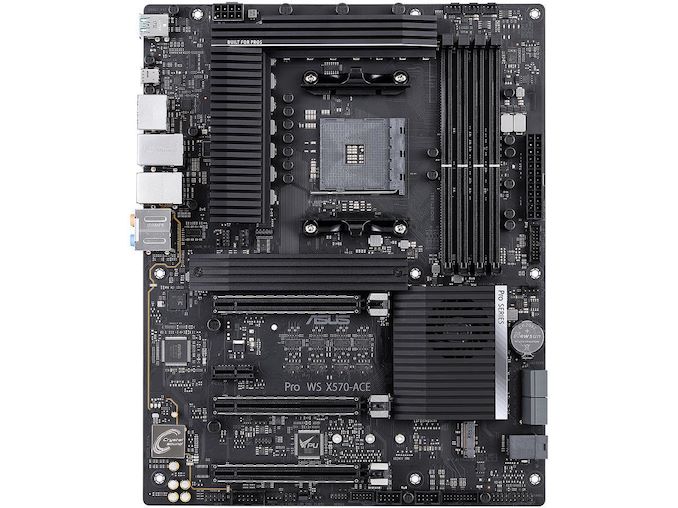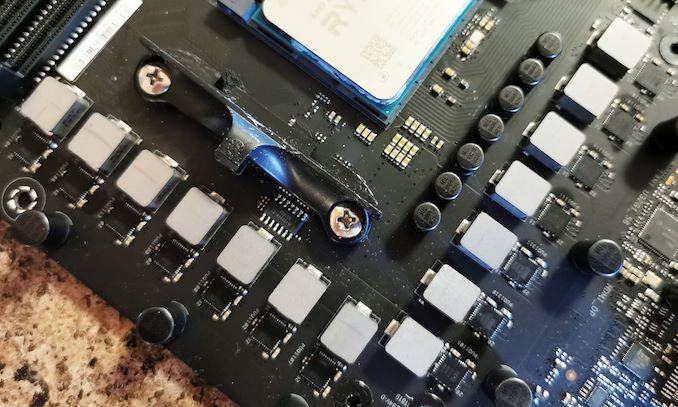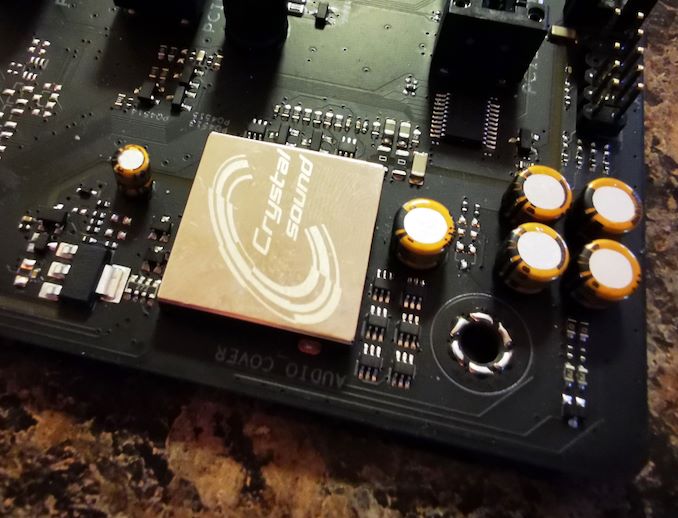The ASUS Pro WS X570-Ace Review: x8x8x8 with No RGB
by Gavin Bonshor on August 12, 2019 9:00 AM ESTVisual Inspection
Setting its sights on professional and workstation users, the ASUS Pro WS X570-Ace encompasses a strict and elegant design without the plethora of RGB LEDs that plenty of other models do. Instead, the Pro WS X570-Ace uses straight angled black aluminium heatsinks with the fins aligned horizontally on an all-black PCB. This includes the power delivery heatsink, the actively cooled X570 chipset heatsink, and the single PCIe 4.0 x4 M.2 heatsink. Located around the edge of the board are six 4-pin headers which support one CPU fan, one AIO pump connector, and four chassis fans. At the bottom of the PCB is an ASUS NODE connector hardware interface controller. While there aren't many products out which support this, InWin is currently developing an OLED screen which can display statistics such as CPU temperature, and fan speeds.
In the top right-hand corner of the board is four memory slots with support for DDR4-4400 memory, and is capable of housing up to 128 GB of system memory. A lot of vendors mention support for ECC memory in its specifications, but the ASUS Pro WS X570-Ace has validated support for ECC memory (and non-ECC). This means users can build an X570 based workstation with all the benefits of ECC memory including options in the firmware for memory scrubbing and memory addressing; this ultimately comes down to processor support including the AMD Ryzen Pro models. The WS X570-Ace also benefits from ASUS's OptiMem which is essentially a method of making the memory trace layout more efficient and can help to reduce memory latencies when overclocking, as well as potentially increase memory frequency yield too.

The bottom full-length PCIe 4.0 slot on the Pro WS X570-Ace operates at x8
One of the main features that sets this model apart from the rest of the current X570 product stack is in its PCIe 4.0 support. The ASUS Pro WS X570-Ace has three full-length PCIe 4.0 slots which operate at x16, and x8/x8, and the bottom slot operates at x8 powered through the chipset. All three full-length slots include a coating of metal armor re-inforcement, and for users looking to use a dedicated soundcard or another networking card, ASUS also includes a single PCIe 4.0 x1 slot.
Although the ASUS Pro WS X570-Ace is more geared towards workstation users, its power delivery is more than suitable for enthusiasts looking to overclock Ryzen 3000 processors too. It has a 12+2 phase design that is controlled by an ASP1405I running at 6+1 which is a custom variation of an International Rectifier IR35201 PWM controller. ASUS has opted to use teaming as opposed to doubling up phases for better transient response across its X570 models. As a result of this, the CPU VCore section is running 12 x IR3555 60 A power stages and the SoC is using 2 x IR3555 60 A power stages which are teamed together in pairs to create the 6+1 design. Delivering power to the processor is a single 8-pin 12 V ATX CPU power input.
Moving onto the storage capabilities of the ASUS WS Pro X570-Ace, we have two PCIe 4.0 M.2 slots with the top M.2 slot allowing for both PCIe 4.0 x4 and SATA drives to be used which includes an M.2 heatsink. The M.2 slot located at the bottom of the board only has support for PCIe 4.0 x2 drives, although this model does include a U.2 PCIe 3.0 x4 slot, and four SATA ports with support for RAID 0, 1, and 10 arrays.
The ASUS Pro WS X570-Ace uses a Realtek ALC1200S HD audio codec which provides five 3.5 mm audio jacks, and an S/PDIF optical output. On the Realtek ALC1200S HD audio codec is an EMI shield and is supported with six gold Japanese audio capacitors. The audio PCB is also separated from the rest of the board's componentry.
On the rear panel are two Ethernet ports, one being Realtek RTL8117 and the other an Intel I211-AT. ASUS has included four USB 3.1 G2 Type-A, one USB 3.1 G2 Type-C, and two USB 3.1 G1 Type-A ports, as well as a pair of video outputs including an HDMI 1.4b, and DisplayPort 1.2. Touching on the Realtek RTL8117 Gigabit NIC, this is supported by the ASUS Control Center Express which is a server-focused application which also doubles up as a management controller. It allows for out-of-band management and hardware-level control.
What's in the Box
Included in the box is a very fundamental accessories bundle which includes four SATA cables, an M.2 screw package, a driver and software installation disc, an I/O shield, and a user manual. The most noteworthy accessory in the bundle is an ASUS VGA holder designed to eliminate sagging in heavyset graphics cards, which can not only damage the card but the PCIe slot too if it isn't secured properly.
- 4 x SATA cables
- Rear I/O shield
- 1 x ASUS VGA holder
- 1 x M.2 screw package
- 1 x Installation disk
- User manual















110 Comments
View All Comments
CrystalCowboy - Monday, August 12, 2019 - link
Look up the specs on the Micron 9300. That should give you appreciation of what is going on in U.2.TheUnhandledException - Monday, August 12, 2019 - link
Yeah it would have been nice to even have it be m.2 OR u.2 can only use one or the other. Having a half speed m.2 on a workstation board seems a bad design tradeoff. I mean I guess you could use one of those x8 expansion slots for two more m.2 but the onboard m.2 should be full speed in this segment.CheapSushi - Tuesday, August 13, 2019 - link
U.2 port is the 2nd most versatile port other than PCIe. Too many "enthusiasts" don't seem to understand it. In fact, you can connect M.2 drives to it, at x4 also. You can even use a cable to hook up 4 SATA drives to it. You can connect an actual U.2 drive too. There's so many options with it.TheUnhandledException - Tuesday, August 13, 2019 - link
You can not connect SATA drives to a u.2 port. You can connect a NVMe m.2 drive to a u.2 port with an adapter but you can also connect a u.2 drive to a m.2 port with an adapter. Given the relatively pricing of u.2 vs m.2 drives short of needing a storage server with 20+ NVMe drives there is little reason to prefer a u.2 port over an m.2 one.Hul8 - Monday, August 12, 2019 - link
Writer: Please check the meaning of "phase".This is not by any means a 12 phase design. It only has 6 distinct phases on main components. Teaming only increases the capacity (per phase).
3DoubleD - Monday, August 12, 2019 - link
Agreed, this bothered me too. If it is a 6+2 controller and there is no doubler, the CPU only receives 6 distinct phases, regardless of the extra chips on the other end. Mobo manufacturers make this complicated enough to sort out, I'd hope these reviews would be more accurate and transparent than the motherboard's marketing page.Whether this makes a significant difference for the intended use case is another thing. They hit the same OC on your Ryzen 3700x sample that you did with the top end x570 boards, so it seems plenty capable with 6 phases to meet the power delivery needs for this CPU, even OC'd.
bananaforscale - Monday, August 12, 2019 - link
This. Go watch Buildzoid videos.Jaguar36 - Monday, August 12, 2019 - link
Does the RTL8125G included with some of Asus's other X570 boards also have a similar POST time hit?TheUnhandledException - Monday, August 12, 2019 - link
Nearly perfect but only 2 lanes on the second m.2. Yuck.eva02langley - Monday, August 12, 2019 - link
The price of these motherboards are getting ridiculous. They cost more than the CPUs.